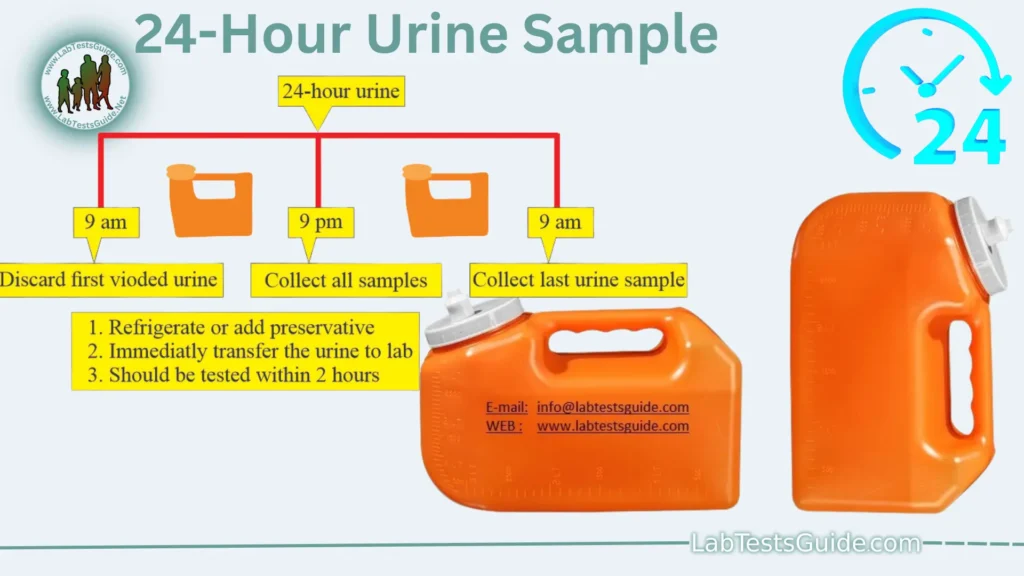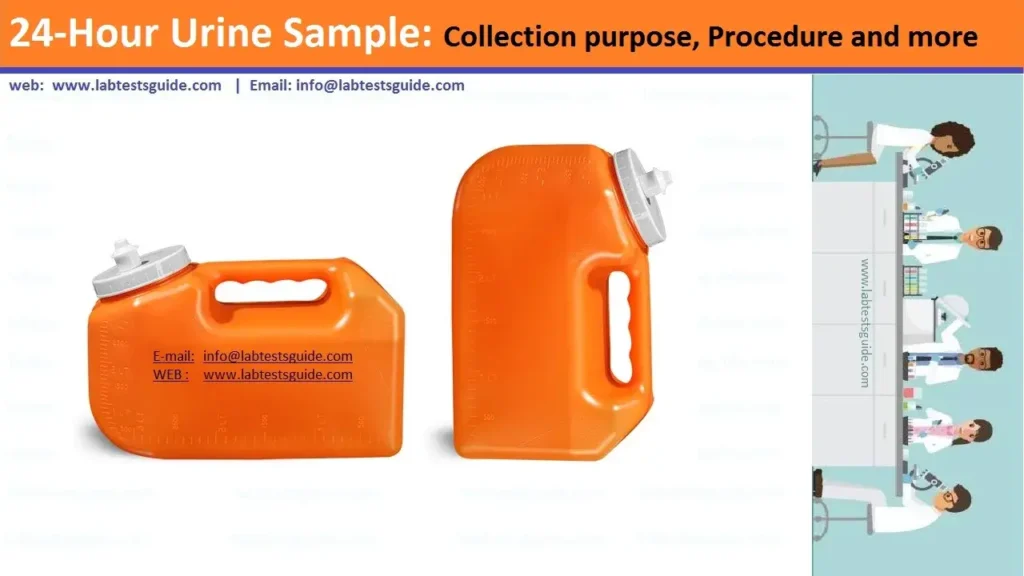A 24-hour urine sample collection is a simple lab test that measures what’s in your urine. The test is used to check kidney function. A 24-hour urine collection is done by collecting your urine in a special container over a full 24-hour period. The container must be kept cool until the urine is returned to the lab.

Collection Process:
Patient Preparation:
- Instructions to the Patient: Provide clear and detailed instructions to the patient on how to perform the 24-hour urine collection accurately.
- Dietary and Medication Guidelines: Explain any dietary restrictions or medication adjustments that may be necessary before and during the collection period.
- Hydration Guidelines: Emphasize the importance of maintaining proper hydration during the collection period.
Collection Container and Materials:
- Selection of Container: Describe the type of container to be used for urine collection and its specifications.
- Handling and Labeling: Explain how to handle the container, ensure its cleanliness, and properly label it with necessary information.
Timing and Recording:
- Start Time: Specify the exact start time for the 24-hour collection, typically following the first morning void.
- Recording Void Times: Instruct the patient on how to accurately record each void time during the 24-hour period.
Storage and Handling:
Storage Instructions: Provide guidelines on where and how to store the urine container during the collection period (e.g., refrigeration).
Avoiding Contamination: Stress the importance of avoiding contamination by ensuring proper storage and hygiene throughout the collection.
Medical Conditions and Indications:
Kidney Diseases:
- Chronic Kidney Disease (CKD): Explain how 24-hour urine samples are used to assess kidney function and diagnose CKD.
- Glomerulonephritis: Describe the role of the test in diagnosing and monitoring glomerulonephritis.
- Nephrotic Syndrome: Discuss the use of the test in evaluating nephrotic syndrome and its treatment.
Monitoring Hormone Levels:
- Cortisol: Explain the significance of 24-hour urine collections in measuring cortisol levels, particularly for conditions like Cushing’s syndrome.
- Catecholamines: Describe the use of the test in monitoring catecholamine levels for conditions like pheochromocytoma.
Other Clinical Uses:
- Pregnancy – Preeclampsia: Discuss how 24-hour urine samples are employed to assess the risk of preeclampsia during pregnancy.
- Calcium and Phosphorus Imbalances: Explain the utility of the test in diagnosing disorders related to calcium and phosphorus metabolism.
- Medication Monitoring: Touch upon cases where the test is used to monitor the impact of specific medications on the kidneys or overall health.
Interpreting Results:
Normal Values:
- Electrolytes: Explain the expected range of electrolyte levels in a 24-hour urine sample, such as sodium, potassium, and chloride.
- Creatinine Clearance: Describe the normal range for creatinine clearance, which reflects kidney filtration.
- Protein Excretion: Specify the typical protein excretion levels in a 24-hour urine sample.
Abnormal Results:
- Elevated Creatinine Clearance: Discuss what elevated creatinine clearance might indicate, such as hyperfiltration in early kidney disease.
- Proteinuria: Explain the significance of proteinuria, which can be an early sign of kidney disease or other health issues.
- Electrolyte Imbalances: Interpret the meaning of high or low levels of specific electrolytes and their potential health implications.
Diagnostic Significance:
- Kidney Function: Explain how the results of a 24-hour urine sample are crucial in assessing overall kidney function.
- Disease Diagnosis: Discuss how abnormal results can aid in diagnosing conditions like chronic kidney disease, glomerulonephritis, or hormonal disorders.
- Treatment Monitoring: Highlight the use of repeated 24-hour urine samples to monitor the effectiveness of treatment plans.
Clinical Context:
- Patient’s Medical History: Emphasize the importance of considering the patient’s medical history when interpreting results.
- Consultation with Healthcare Provider: Stress that the results should be interpreted by a healthcare professional in the context of the patient’s overall health and other diagnostic tests.

Preparing for the Test:
Dietary Restrictions:
- Sodium: Explain any restrictions on high-sodium foods and the importance of a low-sodium diet before and during the test.
- Caffeine: Discuss the need to limit or avoid caffeine intake, as it can affect test results.
- Specific Foods: Mention any other dietary restrictions that may apply depending on the specific purpose of the test, such as protein intake for certain conditions.
Medication Considerations:
- Medication List: Instruct the patient to provide a list of all medications they are taking to the healthcare provider. Some medications can interfere with test results or need to be temporarily adjusted.
- Medication Adjustments: Explain how certain medications may need to be temporarily discontinued or adjusted under the guidance of a healthcare provider.
Hydration Guidelines:
Hydration Importance: Stress the need for proper hydration during the 24-hour collection period to ensure an accurate sample.
Drinking Water: Provide guidelines on drinking plain water and the recommended daily intake.
Collection Container:
- Container Pickup: Explain when and where to pick up the urine collection container, and how to properly prepare it for use.
- Labeling: Describe the process of labeling the container with essential information.
Timing and Recording:
- Start Time: Reinforce the importance of accurately recording the start time following the first morning void.
- Void Times: Remind the patient to diligently record the time of each subsequent void.
Additional Instructions:
- Provide any additional, test-specific instructions based on the patient’s condition or the purpose of the 24-hour urine sample.
Potential Challenges and Errors:
Incomplete Collection:
- Causes: Discuss reasons for incomplete collections, such as forgetting to collect a void or spilling urine.
- Avoidance: Offer strategies for patients to avoid incomplete collections, like setting alarms or reminders.
Contamination:
- Causes: Explain how contamination can occur, for example, through poor hygiene when handling the collection container.
- Prevention: Provide guidelines on maintaining proper hygiene, including handwashing and clean collection techniques.
Incorrect Timing:
- Causes: Highlight factors that can lead to timing errors, such as starting the collection too early or too late.
- Timing Accuracy: Stress the importance of accurately recording the start and end times and following the specified 24-hour period.
Storage Errors:
- Causes: Explain potential issues related to improper storage, like not refrigerating the sample as instructed.
- Storage Guidelines: Remind patients of the importance of proper storage and provide specific instructions.
Diet and Medication Non-Compliance:
- Causes: Address the consequences of not following dietary and medication restrictions.
- Patient Education: Emphasize the significance of adhering to the guidelines to obtain accurate results.
Sample Contamination with Menstrual Blood:
- Recognizing Menstrual Contamination: Explain how menstrual blood contamination can affect results.
- Prevention: Provide guidance on recognizing and preventing menstrual contamination during the collection.
Spills and Accidents:
- Handling Accidents: Offer advice on what to do in case of spills or accidents during the collection process.
- Backup Containers: Suggest having backup containers on hand in case the primary container is compromised.
Sample Analysis:
Laboratory Procedures:
- Receipt and Verification: Explain how the laboratory receives the urine sample, verifies the patient’s information, and ensures the sample’s integrity.
- Sample Preparation: Detail the steps taken to prepare the sample for analysis, including mixing and aliquoting.
Analyzing Collected Urine:
- Chemical Analysis: Describe the various chemical tests performed on the urine sample, including tests for electrolytes, proteins, creatinine, and other relevant substances.
- Hormone Assays: Explain the hormone assays, such as cortisol or catecholamines, and the methodologies used.
- Quality Control: Mention the quality control measures employed in the laboratory to ensure accurate and reliable results.
Interpreting Results:
- Normal Values: Provide reference ranges for common analytes to help interpret results.
- Abnormal Results: Explain how the lab identifies abnormal values and their potential clinical significance.
Diagnostic Significance:
- Kidney Function Assessment: Clarify how the results of various tests are used to assess kidney function.
- Disease Diagnosis: Discuss how abnormal results may lead to the diagnosis of specific medical conditions.
Reporting:
- Report Format: Describe how the results are typically presented in a laboratory report.
- Turnaround Time: Provide information on the expected time frame for receiving the results.
Consultation with Healthcare Provider:
- Emphasize that the results of the 24-hour urine sample should be interpreted by a healthcare provider within the context of the patient’s medical history and overall health.
Reporting and Discussing Results:
Receiving the Results:
- Delivery Method: Explain how patients can expect to receive their test results, whether through in-person consultation, phone calls, online portals, or printed reports.
- Timeline: Specify the expected timeframe for receiving the results from the laboratory.
Understanding the Report:
- Report Components: Describe the key components of the test report, including patient information, test results, reference ranges, and any notes or comments.
- Interpretation Assistance: Mention any resources or contact information available to help patients understand the report.
Consultation with Healthcare Provider:
- Importance of Consultation: Emphasize the significance of discussing the results with a healthcare provider who can provide context and guidance.
- Scheduling an Appointment: Provide instructions on how to schedule an appointment or consultation with the healthcare provider.
Questions to Ask:
- Suggested Questions: Offer a list of suggested questions that patients can ask their healthcare provider about the results, including inquiries about diagnosis, treatment, and follow-up testing.
- Personalized Questions: Encourage patients to ask questions specific to their health and medical history.
Next Steps and Follow-Up:
- Treatment Plans: Discuss the potential development of a treatment plan if the results indicate a medical condition.
- Follow-Up Testing: Explain the possibility of additional tests or monitoring to assess progress and treatment effectiveness.
Patient Advocacy:
- Encourage patients to actively participate in their healthcare and advocate for their needs during the discussion with their healthcare provider.
- Seeking a Second Opinion: Provide information about seeking a second opinion if the patient has concerns or doubts about the initial diagnosis or treatment plan.
FAQs:
hat is a 24-hour urine sample, and why is it collected?
A 24-hour urine sample is a diagnostic test that measures various substances excreted in urine over a 24-hour period. It helps assess kidney function and diagnose certain medical conditions.
How should I prepare for a 24-hour urine collection?
Preparation typically involves following dietary and medication restrictions, staying hydrated, and following specific timing instructions. Your healthcare provider will provide detailed guidance.
Can I take my medications during the 24-hour urine collection period?
It depends on the specific medications you’re taking. Some medications may need to be adjusted or temporarily discontinued during the collection. Consult your healthcare provider for guidance.
What are the common challenges and errors to avoid during the collection process?
Common challenges include incomplete collections, contamination, timing errors, and spills. This section provides tips to avoid these issues.
How long does it take to receive the test results?
The turnaround time for test results varies, but it’s typically within a few days to a week. Your healthcare provider can provide a more precise estimate.
What do abnormal results from a 24-hour urine sample indicate?
Abnormal results can suggest various medical conditions, such as kidney diseases, hormonal disorders, or imbalances in electrolytes. Further evaluation by a healthcare provider is necessary to determine the exact diagnosis and treatment plan.
Do I need to fast or restrict my diet before the 24-hour urine collection?
It depends on the specific purpose of the test. Some tests may require dietary restrictions, such as limiting sodium or protein intake. Follow the instructions provided by your healthcare provider.
Can I exercise during the 24-hour urine collection period?
It’s generally best to avoid strenuous exercise during the collection to prevent excess protein and creatinine excretion. Light activities are usually acceptable, but consult your healthcare provider for specific recommendations.
What happens if I miss a urine collection during the 24-hour period?
Incomplete collections can lead to inaccurate results. If you miss a collection, inform your healthcare provider, as they may advise you on whether to restart the collection or proceed with the available data.
Can I conduct a 24-hour urine collection at home, or do I need to go to a healthcare facility?
You can collect a 24-hour urine sample at home, following the provided instructions. However, healthcare facilities can also assist with the collection process if needed.
Conclusion:
In conclusion, the 24-hour urine sample is a vital diagnostic tool used to assess kidney function and diagnose various medical conditions. Proper preparation and meticulous collection are crucial for accurate results, and understanding the significance of the test and its potential outcomes is essential for informed decision-making. Following collection, the laboratory analysis provides valuable insights, and discussing the results with a healthcare provider is a critical step in interpreting findings and formulating appropriate treatment plans. This comprehensive document offers guidance on the entire process, from preparation to result interpretation, empowering individuals to navigate the 24-hour urine sample test effectively and contribute to their overall healthcare.
Possible References Used






2 Comments